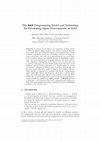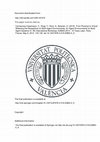Papers by Alessandro Ricci

Proceedings of the 6th International Workshop on Programming Based on Actors, Agents, and Decentralized Control, 2016
Agent programming languages like AgentSpeak(L)-and Jason, as its modern extension/implementation-... more Agent programming languages like AgentSpeak(L)-and Jason, as its modern extension/implementation-have features that make them interesting for software development and general-purpose programming, besides AI problems. A main one is the level of abstraction, that eases the design and development of concurrent, reactive, distributed applications. At the same time, being not developed for general-purpose programming and software development in mind, they typically miss elements that are important for that purpose. These weaknesses can negatively impact on their adoption beyond the agent-oriented programming community. Accordingly, in this paper we discuss some features extending the basic model provided by AgentSpeak(L)/Jason, with the purpose of improving its adoption for programming and software development. Such extensions are shown in practice using a Jason extension called Jona.

ACM Transactions on Internet Technology
In recent years, digital twins have been pervading different application domains—from manufacturi... more In recent years, digital twins have been pervading different application domains—from manufacturing to healthcare—as an approach for virtualising different kinds of physical entities (things, products, machines). The dominant view developed in the literature so far is about the virtualisation of individual physical assets in a closed-system perspective. In this article, we introduce and explore a broader perspective that we call Web of Digital Twins (WoDT), in which the digital twin paradigm is exploited for the pervasive softwarisation of possibly large-scale interrelated physical realities. A WoDT can be conceived as an open, distributed and dynamic ecosystem of connected digital twins, functioning as an interoperable service-oriented layer for applications running on top, especially smart applications and multiagent systems. The article introduces an abstract model and architecture aimed to capture key aspects of the idea not bound to any specific application domains or implement...
Autonomous Agents & Multiagent Systems/Agent Theories, Architectures, and Languages, 2008
Agents and Artifacts" (A&A) and CARTAGO are becoming increasingly popular as, respectively, ... more Agents and Artifacts" (A&A) and CARTAGO are becoming increasingly popular as, respectively, a general-purpose pro- gramming model and a related infrastructure for developing shared computational environments in agent-based software systems. However, so far there has been no work on devel- oping multiagent systems (MAS) where agents implemented and deployed in dierent agent-programming platforms can interact as part of the same

Lecture Notes in Computer Science (including subseries Lecture Notes in Artificial Intelligence and Lecture Notes in Bioinformatics), 2008
In human society, almost any cooperative working context accounts for different kinds of object, ... more In human society, almost any cooperative working context accounts for different kinds of object, tool, artifact in general, that humans adopt, share and intelligently exploit so as to support their working activities, in particular social ones. According to theories in human sciences, such entities have a key role in determining the success or failure of the activities, playing an essential function in simplifying complex tasks and-more generally-in designing solutions that scale with activity complexity. Analogously to the human case, we claim that also (cognitive) multi-agent systems (MAS) could greatly benefit from the definition and systematic exploitation of a suitable notion of working environment, composed by different sorts of artifacts, dynamically constructed, shared and used by agents to support their working activities. Along this line, in this paper we introduce and discuss a programming model called A&A (Agents and Artifacts), which aims at directly modelling and engineering such aspects in the context of cognitive MAS. Besides the conceptual framework, we present the current state of prototyping technologies implementing A&A principles-CARTAGO platform in particular-, and show how they can be integrated with existing cognitive MAS programming frameworks, adopting the Jason programming platform as the reference case.
Since its first edition in 1998, the workshop series “From Agent Theory to Agent Implementation ”... more Since its first edition in 1998, the workshop series “From Agent Theory to Agent Implementation ” has been not only documenting the progress in development and practical deployment of agent-related technologies, but also managed to contribute itself to the rapid development of this area. AT2AI promotes actively the exchange of ideas and experiences between researchers and practitioners working on the whole range of theoretical and application-oriented issues of agent technology. It encompasses both the micro and macro aspects of agent-oriented design, and discusses the relations of drawing boards and partly idealised models to modelling tools and frameworks to deployment, management and maintenance of implementations. The focus of AT2AI lies in the discussion of direct experience reports from all stakeholders, so as to remain well aware of the actual
A relevant application domain for agent-based software is given by smart mobile applications. In ... more A relevant application domain for agent-based software is given by smart mobile applications. In this context, the impressive progress of technologiesmakes it possible to explore the use of agent-oriented programming languages and frameworks based on cognitive architectures. Accordingly, here we provide a description of JaCaAndroid, a framework based on the JaCaMo platform that allows for designing and programming smart mobile apps using BDI-based cognitive agents within the A&A conceptual model.
Lecture Notes in Computer Science, 2015
The impressive development of technologies is reducing the gulf between the physical and the digi... more The impressive development of technologies is reducing the gulf between the physical and the digital matter, reality and virtuality. Mirror worlds MW are agent-based systems that live on this edge. They are meant to be a conceptual blueprint for designing future smart environment systems, providing an innovative conceptual framework for investigating inter-disciplinary aspects --- from cognition to interaction, cooperation, governance --- concerning human-agent mixed-reality and augmented systems. In this paper we focus on the problem of how to concretely design and program mirror worlds, in particular adopting high-level programming abstractions that are provided by state-of-the-art agent-oriented programming models and technologies.
Lecture Notes in Computer Science, 2006
An artefact for MASs is an entity not driven by an inner goal (as agents are), but used by agents... more An artefact for MASs is an entity not driven by an inner goal (as agents are), but used by agents to achieve their own goals. In this paper, we assume agents and artefacts as first-class entities in MAS engineering, and claim that agent-oriented methodologies should exploit these two abstractions as the basic bricks for the whole engineering process. As a first testbed, we take the SODA agent-oriented methodology and draw a possible roadmap for its extension toward the notion of artefact.

The World Wide Web has emerged as the middleware of choice for most distributed systems. Recent s... more The World Wide Web has emerged as the middleware of choice for most distributed systems. Recent standardization efforts for the Web of Things and Linked Data are now turning hypermedia into a homogeneous information fabric that interconnects everything – devices, information resources, abstract concepts, etc. The latest standards allow clients not only to browse and query, but also to observe and act on this hypermedia fabric. Researchers and practitioners are already looking for means to build more sophisticated clients able to meet their design objectives through flexible autonomous use of this hypermedia fabric. Such autonomous agents have been studied to large extent in research on distributed artificial intelligence and, in particular, multi-agent systems. These recent developments thus motivate the need for a broader perspective that can only be achieved through a concerted effort of the research communities on the Web Architecture and the Web of Things, Semantic Web and Linke...

The World Wide Web has evolved drastically over the past decade -- and the proliferation of Web A... more The World Wide Web has evolved drastically over the past decade -- and the proliferation of Web APIs has turned it into the middleware of choice for most distributed systems. The recent focus on hypermedia-driven APIs together with initiatives such as the Web of Things and Linked Data are now promoting and advancing the development of a new generation of dynamic, open, and long-lived systems on the Web. These systems require agent-based solutions to the point that Web researchers have started to build autonomous systems on their own. It is thus both timely and necessary to investigate and align the latest developments in Web research and multi-agent systems (MAS) research. We argue that the answer lies equally in a lack of practical use cases as well as the premature development and alignment of Web and agent technologies. We then present our vision for a new generation of autonomous systems on the Web, which we call hypermedia MAS, together with the research opportunities and chall...

In MAS programming and engineering, the environment and the organisation can be exploited as firs... more In MAS programming and engineering, the environment and the organisation can be exploited as first-class design and programming abstractions besides the agent one. A main example of a platform implementing this view is JaCaMo, which allows the programming of a MAS in terms of an organisation of cognitive agents sharing a common artifact-based environment. However, MAS models and platforms in general do not provide a satisfactory approach for MAS developers to uniformly deal with distribution at multiple dimensions -- agent, environment, and organisation. Typically, environments are either centralised in a single node, or composed by parts that run on different nodes but with a poor support at the programming and execution levels to deal with that. In this paper, we tackle this problem by proposing a model for engineering world-wide distributed environments and organisations for MAS. The approach integrates the A&A (Agents and Artifacts) conceptual model with a web/resource-oriented ...
In this brief position paper, we present our vision for using software agents and related technol... more In this brief position paper, we present our vision for using software agents and related technologies to address the growing need of transcultural health-aware “Guides” for the elderly, an increasingly important topic given the clear trend of population ageing. Such autonomous intelligent guides are employed in smart living/city infrastructures to give emotional and healthcare support for the elderly wherever they are, whether at home, outdoors, or in hospital. The main purpose is to help ageing people to avoid progressive loss of physical, cognitive, and emotional activity, and most importantly to avoid social exclusion.
Engineering Multi-Agent Systems, 2019
In this paper, we introduce AgentSpeak(ER), an extension of the AgentSpeak(L) language tailored t... more In this paper, we introduce AgentSpeak(ER), an extension of the AgentSpeak(L) language tailored to support encapsulation. The AgentSpeak(ER) extension allows for significantly improving the style of BDI agent programming along relevant aspects, including program modularity and readability, failure handling, and reactive as well as goal-based reasoning. The paper introduces the novel language based on AgentSpeak, illustrates the features of the language through examples, and shows results of experiments evaluating the proposed language.

Engineering Multi-Agent Systems, 2019
A well studied problem in the engineering of open MASs is to enable uniform interaction among het... more A well studied problem in the engineering of open MASs is to enable uniform interaction among heterogeneous agents. However, AOSE as a field has grown to recognize that a MAS consists of more than only agents and thus should be designed on multiple dimensions (including the environment, organization etc.). The problem of enabling interaction among heterogeneous entities across dimensions is either not considered, or it is addressed in an ad hoc and non-uniform manner. In this chapter, we introduce a novel approach to use hypermedia as a general mechanism to support uniform interaction in MASs. The core idea is that agents use hypermedia to discover at runtime (i) other entities in a MAS (e.g., other agents, tools, organizations) and (ii) the means to interact with those entities (e.g., interaction protocols, APIs). This reduces coupling and enhances the scalability and evolvability of the MAS. We present a demonstrator that supports these claims. We believe that a hypermedia-based mechanism for uniform interaction in MASs could provide a foundation for engineering worldwide MASs.

Proceedings of the Eighth International Workshop on the Web of Things, 2017
By abstracting devices to Web resources, the Web of Things (WoT) fosters innovation and rapid pro... more By abstracting devices to Web resources, the Web of Things (WoT) fosters innovation and rapid prototyping in the Internet of Things (IoT): it enables developers to use standard Web technologies for creating mashups of Web services that perceive and act on the physical world (a.k.a. physical mashups). In recent years, however, it has become apparent that current programming paradigms for Web development have important shortcomings when it comes to engineering IoT systems: static Web mashups cannot adapt to dynamic IoT environments, and manually mashing-up the IoT does not scale. To address these limitations, WoT researchers started to look for means to engineer WoT systems that are more autonomous in pursuit of their design objectives. The engineering of autonomous systems has already been explored to a large extent in the scienti c literature on arti cial intelligence. In this position paper, we distill that large body of research into a coherent set of abstractions for engineering autonomous WoT systems.

ACM SIGSOFT Software Engineering Notes, 2019
The continuous integration of software-intensive systems together with the ever-increasing comput... more The continuous integration of software-intensive systems together with the ever-increasing computing power offer a breeding ground for intelligent agents and multi-agent systems (MAS) more than ever before. Over the past two decades, a wide variety of languages, models, techniques and methodologies have been proposed to engineer agents and MAS. Despite this substantial body of knowledge and expertise, the systematic engineering of large-scale and open MAS still poses many challenges. Researchers and engineers still face fundamental questions regarding theories, architectures, languages, processes, and platforms for designing, implementing, running, maintaining, and evolving MAS. This paper reports on the results of the 6th International Workshop on Engineering Multi-Agent Systems (EMAS 2018, 14th-15th of July, 2018, Stockholm, Sweden), where participants discussed the issues above focusing on the state of affairs and the road ahead for researchers and engineers in this area.

The Knowledge Engineering Review, 2019
Research on Multi-Agent Systems (MAS) has led to the development of several models, languages, an... more Research on Multi-Agent Systems (MAS) has led to the development of several models, languages, and technologies for programming not only agents, but also their interaction, the application environment where they are situated, as well as the organization in which they participate. Research on those topics moved from agent-oriented programming towards multi-agent-oriented programming (MAOP). A MAS program is then designed and developed using a structured set of concepts and associated first-class design and programming abstractions that go beyond the concepts normally associated with agents. They include those related to environment, interaction, and organization. JaCaMo is a platform for MAOP built on top of three seamlessly integrated dimensions (i.e. structured sets of concepts and associated execution platforms): for programming belief desire intention (BDI) agents, their artefact-based environments, and their normative organizations. The key purpose of our work on JaCaMo is to su...
Proceedings of the 6th International Workshop on Programming Based on Actors, Agents, and Decentralized Control - AGERE 2016, 2016
An important feature of goal-oriented programming languages is that agents are able to easily pur... more An important feature of goal-oriented programming languages is that agents are able to easily pursue multiple goals concurrently. However, there is an issue when some concurrent goals may conflict with others. Pursuing conflicting goals concurrently can lead an agent to undesirable behavior, in which case pursuing them concurrently should be avoided. In this paper, we address some such problems ranging from how to specify conflicts among goals to handling conflicts at run-time when they are detected.

Lecture Notes in Computer Science, 2015
Since more than a decade, the environment is seen as a key element when analyzing, developing or ... more Since more than a decade, the environment is seen as a key element when analyzing, developing or deploying Multi-Agent Systems (MAS) applications. Especially, for the development of multi-agent platforms it has become a key concept, similarly to many application in the area of location-based, distributed systems. An emerging, prominent application area for MAS is related to Virtual Environments. The underlying technology has evolved in a way, that these applications have grown out of science fiction novels till research papers and even real applications. Even more, current technologies enable MAS to be key components of such virtual environments. In this paper, we widen the concept of the environment of a MAS to encompass new and mixed physical, virtual, simulated, etc. forms of environments. We analyze currently most interesting application domains based on three dimensions: the way different "realities" are mixed via the environment, the underlying natures of agents, the possible forms and sophistication of interactions. In addition to this characterization, we discuss how this widened concept of possible environments influences the support it can give for developing applications in the respective domains.









Uploads
Papers by Alessandro Ricci